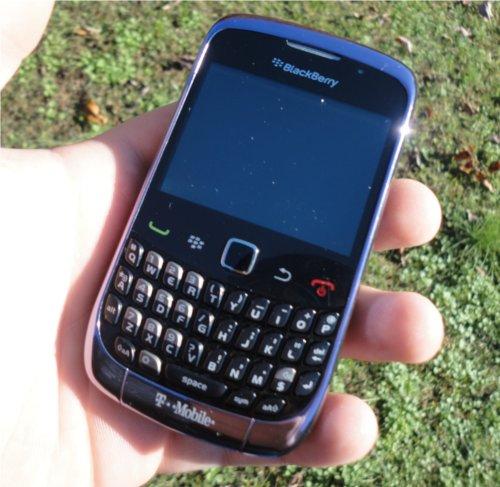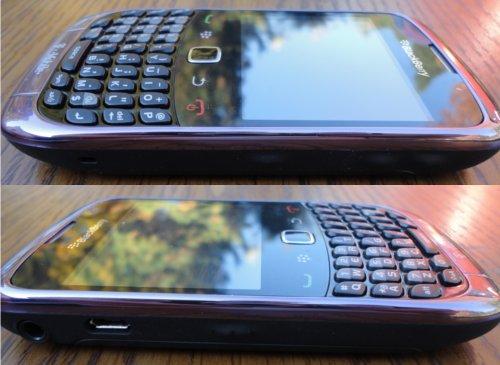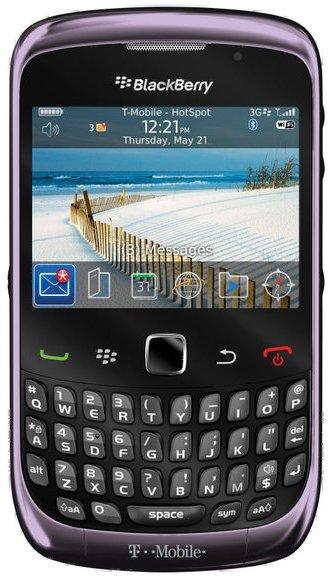
RIM's line of BlackBerry Curve devices have always been fairly popular since their release back in early 2007. It was their second “consumer-centric” device (after the Pearl) and it spread like a wildfire. Other smartphones at the time were just plain bulky and the Curve offered a smartphone solution without weighing down the user. The front-facing QWERTY became the BlackBerry trademark, and what people came to expect. We're now three generations down the line and three years down the road. Very little has actually changed, honestly.
Upon opening the box you will find the device and battery, a USB wall adapter for charging, a microUSB cord for charging and data transfer, the standard BlackBerry headset, and a Desktop Manager installation CD. These are all the typical contents of any BlackBerry you would buy from any carrier. One thing I've noticed is in the past year, RIM or the carrier has stopped packaging cases with the devices. Before, a little pouch to keep your Curve in would be supplied, now the case is left to the buyer to provide themselves.
On the top edge of the device you have three buttons dedicated too the MP3 portion of the device; previous, play/pause (which doubles as a standby and mute key), and next. Along the right edge there is the volume rocker and the right-side convenience key that can be set to nearly anything. On the left edge is a 3.5 mm headphone jack, the microUSB charging port, and one more customizable convenience key. On the back of the device lays a flash-less 2.0 MP camera, and the new style battery door. Behind the battery door is a microSD card slot, and a slot for your SIM card underneath the battery. This new battery door gives the phone a more rugged feel in the hand and better grip to help prevent slipping through fumbling fingers. There is nothing new about the front of the device with its 320 by 240 resolution TFT LCD display, notification LED on the top right corner, the standard call, menu, back, end call buttons, and trackpad. As always, here lies the notable BlackBerry Curve-style keyboard too.
The layout of this device is litterally no different than the 3G-less Curve 8500 series. The only physical differences are going to be the rubber tabs between the call key, menu key, back key, and end call key (they're gone); the bezel colors are metallic rather than a solid, saturated color; the bottom lip; and the overall build quality.
When you turn on the device, you will see absolutely nothing new. The 9300 is running BlackBerry OS 5.0 and the UI is no different from any other BlackBerry. If the stock BlackBerry UI is too bland for you, there is always the option to theme from BlackBerry App World. This device does come BlackBerry 6-ready, which gives it a leg-up over the majority of the other BlackBerry devices out there (save the 9800, 9700, 9780, and 9650). But until T-Mobile releases BlackBerry 6 for the 9300, you are stuck on old BlackBerry software.
I've used the device quite a bit over the last few days. Poking and prodding, trying to get it to lag by opening every application up that I could at once, and I never seemed to get the “hourglass of death.” From my experience with BlackBerry (four years now), I have learned that the devices never seem to lag right out of the box. It usually takes weeks or months before you see any hourglass. This device does seem to be snappier than any other Curve model though. Running side-by-side against my Torch, applications load quicker (due to no user interface animations), and everything just has a fast feel to it.
Comparing the call quality of the 9300 to the Motorola Droid X and BlackBerry Torch I have laying around, it was comparable. The in-ear speaker was loud and clear, and the person I was called noted decent quality as well. The speaker for speakerphone is extremely loud. Turning the volume down didn't seem to make much of a difference, but a speakerphone that is too loud is better than one not being loud enough. I could hold the phone an arm's length away and the person on the other line said they could still hear me clearly, though the surrounding atmosphere wasn't loud. T-Mobile service at my house is very spotty (varying between 0-3 bars EDGE), but I never dropped a call.
The Curve 3G packs an underwhelming 2.0-megapixel camera without a flash. The camera is fixed-focus but seems to work well and for 2.0-megapixels, it takes a decently clear picture. This is a little disappointing as most messaging phones these days have a 3.2-megapixel camera with auto-focus, and most low-end smartphones are 3.2 and up. Directly after taking a picture the screen prompts you to either take another picture, set picture as wallpaper or contact photo, rename, delete, or send as email or MMS. The digital zoom will increase up to five times digital zoom but greatly decreases the quality of the picture. You also have the option to change the picture taking size, quality, white balance (auto, sunny, cloudy, night, incandescent, or fluorescent), color effect (normal, black & white, or sepia), and geotagging.
It totes a 1150 mAh battery, which is typical of the Curve series of phones. It's hard to exactly judge the battery life on this one as I've only had it a few days and haven't really had the chance to “put it to the test.” I made a few phone calls and did a little internet browsing on it, but nothing truly testing of the battery. It's been off the charger for two days and it's sitting at a nice 75% battery left. Again, it hasn't been used a lot though.
Internet browsing on the Curve 9300 is bearable, and that's about it. It's painfully slow whether on Wi-Fi, EDGE, or 3G. This is typical of any BlackBerry on OS 5.0 or below, and after getting the BlackBerry 6 update, you will find large improvement with the WebKit browser. The screen is just a tad small for comfortable web browsing unless you visit the mobile version of a website. Having the trackpad for input as a pointer is a huge plus though.

The Curve 3G is definitely the best of RIM's Curve line. However, they failed to improve greatly with it. Jumping from device model 8500 to 9300, you would expect a great deal of changes, but the only real change was internal with the capability to upgrade to BlackBerry 6 and a color change. For $79.99 with a two-year contract, the Curve 3G isn't a bad choice, but I don't think it constitutes a $30-50 price jump from the 8500 series. The casing feels cheap, but the build is solid. This device it ideal for a light to moderate smartphone user looking to take care of some serious email while on the go. It's great for social media and staying in touch, but it isn't ideal for media (YouTube, browsing internet, etc.).

What's Good: Cheap price tag ($79.99 with a two-year contract) makes the entry-level smartphone more affordable; two nice color choices; little to no lag; media buttons on top provide for a good MP3 solution; easily pocketable.
What's Bad: All plastic casing; Running BlackBerry OS 5.0; the keyboard is a little wobbly; 2.0 MP camera leaves room for improvement.
The Verdict: The BlackBerry Curve 3G (9300) is a good solution for someone looking for an entry-level smartphone. A power user might find themselves looking for more. The camera and the wobbly keyboard really take away from the better parts of this device. Overall, you're going to get what you expect out of this device, the BlackBerry experience. Nothing more, nothing less.